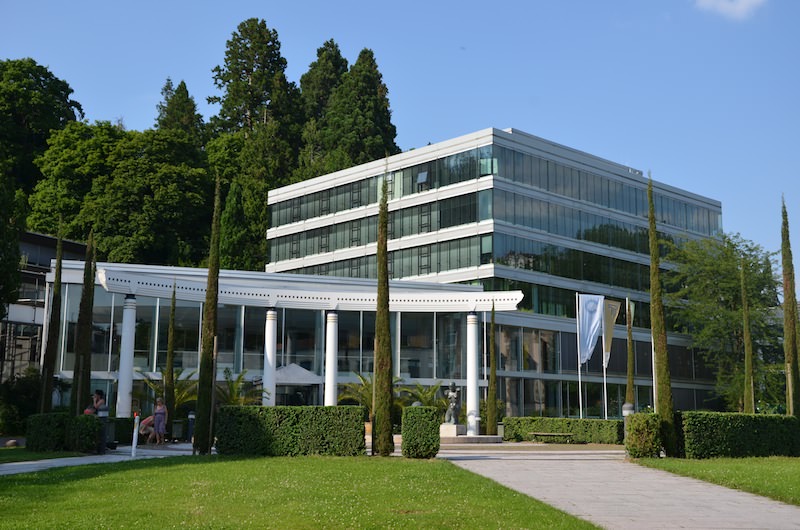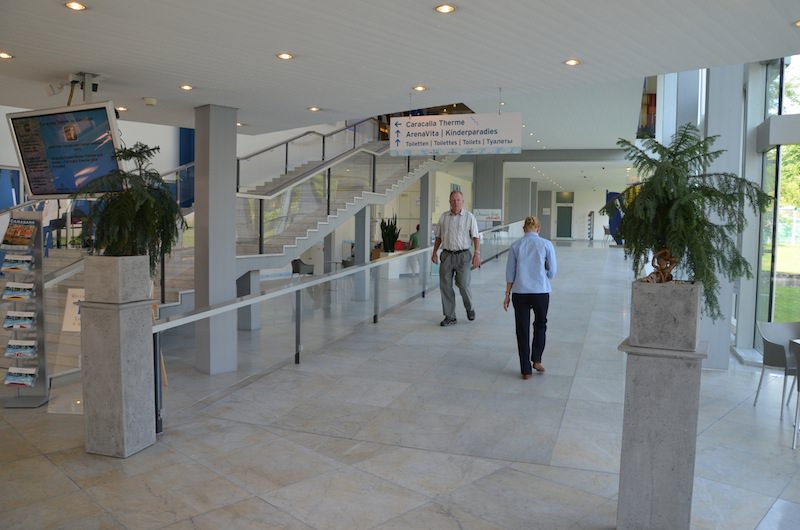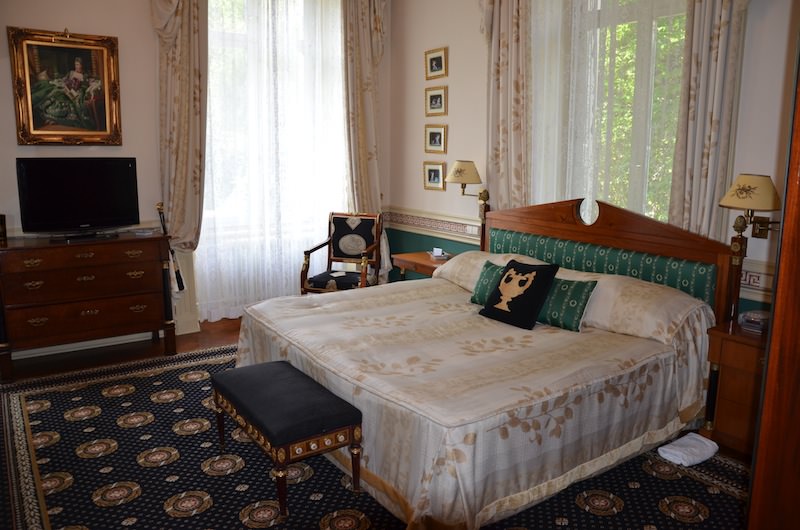The immaculate little town of Baden-Baden, tucked away in the foothills of S.W. Germany’s Black Forest, is a luxurious cross between Monte Carlo, Paris, a spa, and an English park.
Within a few minutes’ walk in Baden-Baden you can see the world’s most beautifully appointed casino, stroll through a verdant green park that is a dead ringer for an English Victorian garden, and sip an espresso beside a perfectly restored, medieval cobble stone street lined with upscale boutique shops. And, close by, you can relax in the warm thermal mineral waters at the Caracalla-Therme or the Friedrichsbad hot water pools.
My tour of Baden-Baden starts along the Lichtentaler Allee, a beautifully sculpted 3-kilometer long promenade that would make the British proud. It could be any one of England’s finely manicured parks. Tall shady oaks grow in straight rows along the roadway. Ornately carved fountains dot the landscape.

My tour of Baden-Baden starts along the Lichtentaler Allee, a beautifully sculpted 3-kilometer long promenade that would make the British proud. It could be any one of England’s finely manicured parks.
This spectacular park has been around for 350 years, so it’s no wonder Baden-Baden has been called the “summer capital of Europe” as early as the 19th century. It doesn’t take much to imagine this fashionable promenade in Victorian times: men dressed in frock coats and top hats and elegant women in hooped dresses with floral hats and parasols, as they clip clop along the road in two-person horse carriages, politely tipping their hats to the passersby.
As we amble along the pathway beside the gently flowing Oos River that bisects Baden-Baden, my guide tells me about the town’s history. “The ancient Roman baths here in AD 80 were the precursors to the medicinal hot baths that draw people to the town today”, she tells me. “The name Baden-Baden translates loosely into “taking the cure”, she adds, “Which is why people today come from far and wide to soak in the warm water.”
Despite earlier ravages by war the town had become a well-established and fashionable resort by the end of the 18th century. People came here to stroll, eat, gamble, attend concerts, and generally be seen, as they were wont to do in La Belle Époque. Halfway along Lichtentaler Allee we stop for a tour of the Museum Frieder Burda, a snow white colored building that blends surprisingly well with the surrounding landscape. The museums curator tells me that their expressionist Frieder Burda Collection comprises around 1000 paintings, sculptures, and drawings.

We admire the Museum’s architecture, modern, but tasteful. A series of long, sloping walkways link each gallery, with high ceilings and tall white pillars that give the feeling of wide-open spaces.
This classical modern collection includes 8 Picassos and a fine selection of German post-war art. We admire the Museum’s architecture, modern, but tasteful. A series of long, sloping walkways link each gallery, with high ceilings and tall white pillars that give the feeling of wide-open spaces.
Next door, the Staatliche Kunsthalle, the town’s renowned art gallery alternates famous international exhibitions. Further along “Culture Row” we take a quick walk through the 19th century Kurhaus. The austere white exterior of the Kurhaus—with eight towering Corinthian pillars—belies what lies inside.
Considered the most beautiful and lavish casino in the world, the majestic Kurhaus building has been the social center of Baden-Baden for centuries, hosting numerous events and concerts. Brahms, Liszt, and Schumann have played here. The Kurhaus’s opulent interior furnishings would impress even James Bond on a heavy-drinking day, I think, as we admire the rich red and velvet trimmings, gilded chandeliers, gold-leaf covered molding, and priceless Chinese vases.

Further along “Culture Row” we take a quick walk through the 19th century Kurhaus. The austere white exterior of the Kurhaus—with eight towering Corinthian pillars—belies what lies inside.
The casino resembles the French palace at Versailles, which I suppose should not be surprising because the French border is only 10 kilometers away. Needless to say, there’s a dress code to enter this hallowed gambling hall, and it’s not jeans and t-shirts (tie and jacket for gentlemen and formal attire for ladies please, plus passport).
We move on to the Trinkhalle, formerly the pump room and now the town’s tourist information center and café. An imposing Colonnade of 16 Corinthian pillars supports the Trinkhalle’s long facade. High up on its red-tiled exterior walls are 14 large baroque murals. It’s worth spending some time gazing at them because they encapsulate this Baroque town perfectly.
We walk across the river into the immaculate Old Town. No litter, manicured brick and stone streets, and all the Renaissance buildings perfectly restored and preserved. The shop windows tastefully display expensive watches, name brand clothing and souvenir knick-knacks.
But it’s time to take the curative waters. My tour ends at the Friedrichsbad and Caracalla pools, only two minute’s walk apart. I explore the 19th century Romanesque-style Friedrichsbad pools (opened in 1877), admiring the long stairs leading up to the baths. Floral paintings everywhere on the curved ceiling and potted plants highlight the bath’s simple elegance.

I explore the 19th century Romanesque-style Friedrichsbad pools (opened in 1877), admiring the long stairs leading up to the baths.
Beneath the Friedrichsbad Thermes, I’m shown the remains of the original Roman baths. The ruins are surprisingly intact and the ingenious floor heating system shows how advanced Roman architecture was for its time.

the state-of-the-art Caracalla Therme complex vibrates with modernity. Constructed in 1985, this is a glass-fronted shrine to the town’s mineral waters.
Now for the Caracalla Therme! While the Friedrichsbad Thermes reflect old world elegance, the state-of-the-art Caracalla Therme complex vibrates with modernity. Constructed in 1985, this is a glass-fronted shrine to the town’s mineral waters. Inside Caracalla (named after a Roman emperor), it’s all airy wide hallways and marble flooring, covering 32,000 square feet.

Inside Caracalla (named after a Roman emperor), it’s all airy wide hallways and marble flooring, covering 32,000 square feet.
After showering, I enter the spa pool. I’ve been looking forward to this all day. The warm, soothing water embraces me. I read that it’s 68 degrees Celsius, perfect. Temperatures range from 64 degrees F to 101 degrees F, depending on what pool you choose. I almost fall asleep sitting on the steps, the water gently washing over me. After an hour in the circular center therme (pool), I venture outside and relax in the slightly cooler outdoor pools. Bliss!

After showering, I enter the spa pool. I’ve been looking forward to this all day. The warm, soothing water embraces me. I read that it’s 68 degrees Celsius, perfect.
After a couple of hours of liquid relaxation, I walk through Baden-Baden’s winding little streets and stop at a Bistro for a meal and some people watching. The buildings lining the narrow streets are painted in muted pastels, like a Disneyland film set of a renaissance town.

I walk through Baden-Baden’s winding little streets and stop at a Bistro for a meal and some people watching.
My table is uneven, from the sloping brickwork, but somehow it just doesn’t seem to matter after my day exploring Baden-Baden. My meal is about twice what I’d pay back in Seattle, but this is also no surprise. I slog back to my hotel, La Belle Époque, and pour myself into bed, clothes and all. The water has relaxed me to the point of incoherence. Not a bad day.

La Belle Époque translates into “The Beautiful Era”, the period in French history (1871 to 1914) characterized by peace and prosperity and a vital resurgence of literature, theater, arts and music. How fitting then, that this hotel reflects this sumptuous period.
Some advice: Don’t visit Baden-Baden unless you have deep pockets. Don’t even think about it. It’s at the other end of the spectrum from your basic backpacker’s haunt or a budget family destination. But if you have the funds to visit and stay in this chic, luxurious little village of 55,000 landed souls, you’ll see a slice of upscale heaven—with everyone purring along in expensive black Beamers and Mercedes. Dressed to the nines, of course. And I say all this in the kindest way possible. I saw no evidence of snobbish behavior—just the well-heeled enjoying the finer things in life and pretty much ignoring everyone else. I was entranced with the place.
Queen Victoria, Mark Twain, Peter Sellers, Bono, President Clinton, and the Beckhams have graced Baden-Baden with their presence. It’s not your average tourist destination—more of an understated, haute couture experience where you’ll see many of Europe’s aristocrats enjoying themselves. One evening, I really did see a superbly garbed and coiffed lady, resplendent with huge strings of sparkling white pearls strewn everywhere, holding a lace parasol high overhead, strolling through the streets without the slightest trace of self-consciousness. Her outfit and jewelry no doubt cost the equivalent of a year’s worth of my mortgage payments, or more. It all seems perfectly acceptable here. Where else but Baden-Baden, for example, would you find a Faberge Museum?
Baden-Baden is a great place to release your inner billionaire and make believe that you’re one of Europe’s landed class, as you flit from spa treatment to thermal baths to the casino—and then live a life of indentured servitude for the next twelve months, paying off your credit card. Your indulgent hotel concierges and restaurant waiters will be more than happy to indulge this fantasy.
Where to Stay in Baden Baden
La Belle Époque translates into “The Beautiful Era”, the period in French history (1871 to 1914) characterized by peace and prosperity and a vital resurgence of literature, theater, arts and music. How fitting then, that this hotel reflects this sumptuous period. La Belle Epoque is considered one of the finest hotels in Baden-Baden, and I would not doubt this for a second. Each room is superbly decorated in a renaissance Belle Epoque theme, yet furnished with state-of-the-art technology.

La Belle Epoque is considered one of the finest hotels in Baden-Baden, and I would not doubt this for a second.
The villa is located in a park and has a gorgeous salon for dining. The breakfast buffet was superb, as is, apparently, the high tea in afternoons. It’s only a short walk to the Lichtentaler Allee from here, and a short walk to the Old Town.
Written by and photos (unless noted) by Roy Stevenson for EuropeUpClose.com


Wiesbaden: Spas, Sightseeing and a Stunning Hotel
Friday 10th of October 2014
[…] amazing how two German spa towns can be so different. I’d been staying in the small town of Baden-Baden, tucked away in the foothills of S.W. Germany’s Black Forest. From there I went straight to […]
Europe's Spas: Getting Naked With the Locals
Saturday 23rd of August 2014
[…] You can also Take in the Waters in Baden Baden, Germany […]
Rosanna
Wednesday 30th of April 2014
My husband and I went on a 3 week honeymoon to Europe in 2012. Our stay in Baden-Baden was our favorite part of the trip. We liked the combination of luxury and decadence, coupled with the natural surroundings. We spent the days hiking and the evenings at the thermal baths or casino. We stayed at the Hotel am Markt, which served a hearty and delicious breakfast. We're longing to go back! Next time we visit, I'll have to check out the Museum Frieder Burda. I can't believe I missed it the first time around!